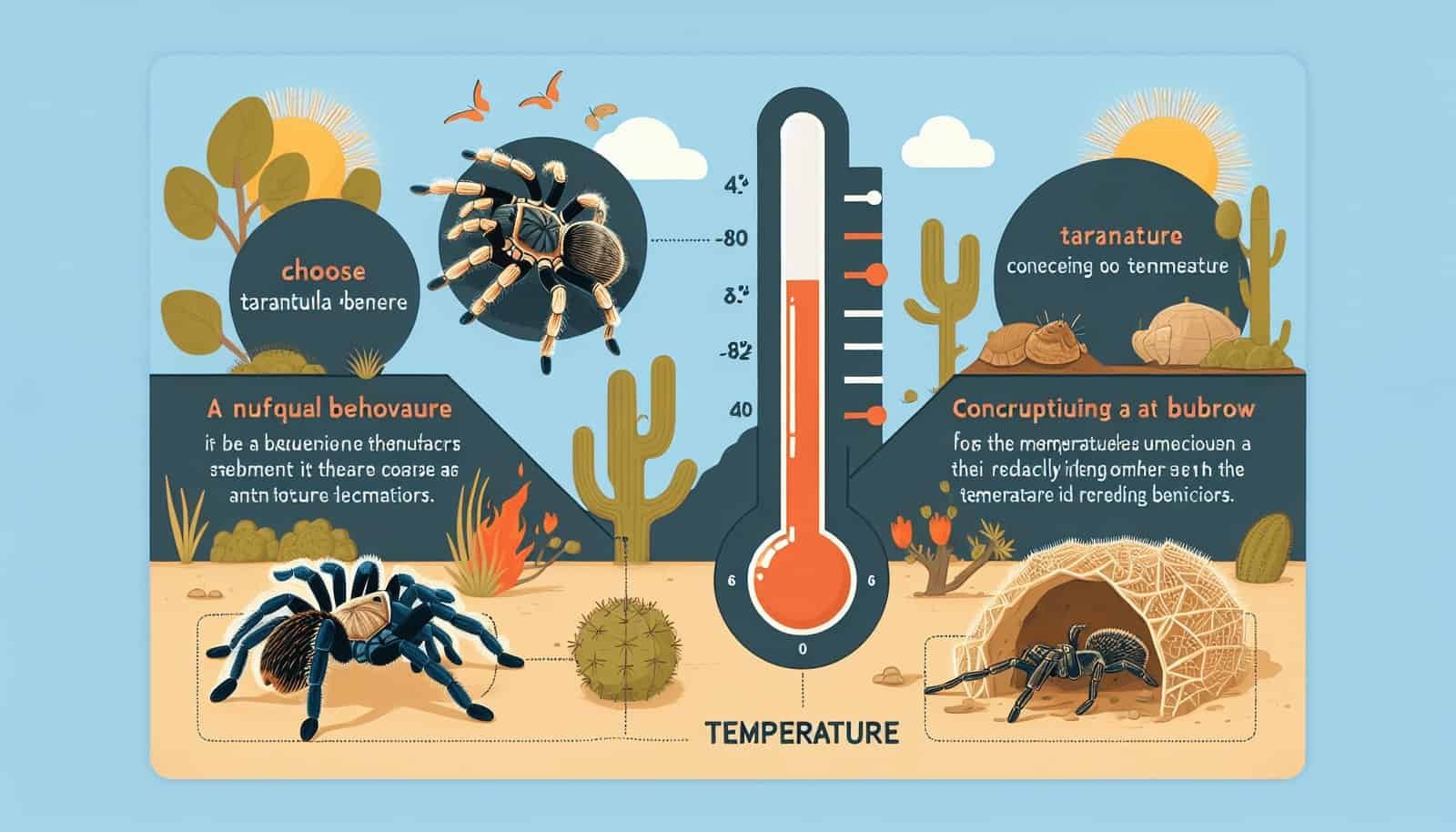In the fascinating world of tarantulas, temperature plays a crucial role in shaping their breeding behavior. Understanding this relationship between temperature and tarantula reproduction not only offers insights into their remarkable adaptation skills but also sheds light on potential strategies to foster successful breeding in captivity. As we dive into the intricate intricacies of these creepy crawlers, we uncover the secrets behind their temperature-dependent mating rituals and the implications for tarantula hobbyists and enthusiasts alike. Explore how something as simple as heat can have a profound impact on the captivating world of tarantula breeding.
Introduction
Tarantula breeding behavior is influenced by various factors, with temperature playing a crucial role. Temperature affects not only the mating success and courtship displays of tarantulas but also the development of eggs and the sex ratio of offspring. Understanding the temperature preferences and thermoregulation abilities of tarantulas is essential for successful breeding in captivity.
Temperature and Tarantula Breeding
Overview of tarantula breeding behavior
Tarantulas exhibit complex breeding behavior, involving courtship displays and mating rituals. Male tarantulas often engage in elaborate dances or drumming to attract female partners. Understanding the intricacies of their mating behavior is important for successful captive breeding programs.
Importance of temperature in tarantula breeding
Temperature plays a crucial role in tarantula breeding, as it directly impacts their physiology, behavior, and reproductive success. Both males and females have specific temperature preferences for various stages of breeding, including courtship, egg development, and hatching. Maintaining optimal temperatures is vital to ensure successful reproduction in tarantulas.
Temperature Preferences of Tarantulas
Optimal temperature range for tarantula breeding
Tarantulas have specific temperature preferences for successful breeding. The optimal temperature range for courtship and mating varies among species but typically falls between 75°F (24°C) and 85°F (29°C). Mating attempts outside this range may result in reduced success rates.
Effects of temperature extremes on tarantulas
Extreme temperatures, both hot and cold, can have detrimental effects on tarantulas. High temperatures can lead to dehydration and overheating, while low temperatures can slow down their metabolism and reproductive processes. It is crucial to avoid exposing tarantulas to extreme temperatures to ensure their well-being and breeding success.
Species-specific temperature preferences
Different tarantula species may have distinct temperature preferences for breeding. Some species may thrive in warmer climates, while others prefer cooler temperatures. Understanding the specific needs of each species is essential for creating appropriate breeding conditions in captivity.
Thermoregulation in Tarantulas
Tarantula physiology and thermoregulation
Tarantulas, like other ectothermic organisms, rely on external heat sources to regulate their body temperature. They have specialized physiological mechanisms that enable them to absorb and retain heat from their environment. Understanding their thermoregulation abilities is crucial for maintaining optimal breeding temperatures.
Behavioral adaptations for temperature regulation
Tarantulas exhibit various behavioral adaptations for temperature regulation. They may bask in the sun or seek shade to control their body temperature. Burrowing can also serve as a way to escape extreme temperatures, providing tarantulas with a more stable microclimate. Providing appropriate temperature gradients in captivity allows tarantulas to exhibit natural thermoregulatory behaviors.
Temperature’s Impact on Courtship Behavior
Effects of temperature on courtship displays
Temperature significantly affects courtship behavior in tarantulas. Certain courtship displays, such as drumming or vibrating leg movements, may be more pronounced or frequent at specific temperatures. The temperature can influence the intensity and duration of courtship rituals, indicating its crucial role in successful mating.
Influence of temperature on mating success
Mating success in tarantulas is closely linked to temperature. In some species, higher temperatures during courtship can increase the likelihood of successful copulation. Maintaining optimal temperatures during courtship is crucial for ensuring successful mating outcomes and potential egg production.
Temperature-related changes in courtship behavior
Temperature can induce changes in courtship behavior in tarantulas. Males may alter their courtship displays or intensity based on the temperature they perceive. Understanding these temperature-related changes can help breeders create appropriate conditions to facilitate successful courtship and mating.
Temperature and Egg Development
Temperature-dependent egg development
The temperature during incubation directly influences the development of tarantula eggs. Different species may have specific temperature requirements for optimal development. Maintaining consistent and appropriate temperatures is crucial for healthy egg development and eventual hatching.
Temperature influence on hatching success
Temperature plays a vital role in hatching success. Eggs incubated at temperatures outside the optimal range may have reduced hatching rates or produce weak, unhealthy offspring. Accurately maintaining the temperature during incubation is crucial for breeding programs aiming for high hatching success rates.
Variation in incubation temperatures and outcomes
Some tarantula species may exhibit temperature-dependent outcomes during incubation. For example, lower temperatures may result in the development of male offspring, while higher temperatures may yield female offspring. Understanding these temperature-dependent outcomes can be valuable for managing breeding programs and maintaining genetic diversity.
Effects of Temperature on Offspring Sex Ratio
Temperature-dependent sex determination in tarantulas
Temperature plays a significant role in determining the sex of tarantula offspring. In some species, the incubation temperature influences the sex ratio of hatched offspring. This temperature-dependent sex determination contributes to the genetic diversity and population dynamics of tarantulas.
Influence of temperature on offspring sex ratios
Fluctuations in incubation temperatures can lead to variations in offspring sex ratios. Higher incubation temperatures may favor female offspring, while lower temperatures may result in higher proportions of males. Managing temperature conditions during incubation can help maintain a balanced sex ratio and healthy tarantula populations.
Role of Temperature in Breeding Season Timing
Temperature cues for breeding season initiation
Temperature serves as an essential cue for triggering the breeding season in tarantulas. Certain temperature thresholds or fluctuations can signal the onset of breeding behaviors in both males and females. Understanding these temperature cues is crucial for successfully timing breeding programs and facilitating natural reproductive cycles.
Temperature’s role in synchronizing breeding behavior
Temperature synchronizes the breeding behavior of tarantulas within a population or species. When individuals experience similar temperature patterns, they are more likely to exhibit mating behavior simultaneously. This synchronization optimizes reproductive success and genetic exchange within tarantula populations.

Climate Change and Tarantula Breeding
Potential effects of climate change on tarantula breeding
Climate change poses potential risks and challenges to tarantula breeding. Rising temperatures, changing rainfall patterns, and habitat destruction can disrupt the natural breeding cycles and behavior of tarantulas. It may also affect the availability of suitable temperature conditions for successful courtship, egg development, and mating.
Adaptation and resilience of tarantula populations
Tarantulas, like many other organisms, have the capacity to adapt and display resilience in the face of environmental changes. However, the magnitude and rate of climate change may pose significant challenges for tarantula populations in the long term. Conservation efforts and captive breeding programs can play a crucial role in safeguarding their genetic diversity and survival.
Conclusion
Temperature plays a pivotal role in various aspects of tarantula breeding, including courtship behavior, egg development, sex determination, and breeding season timing. Maintaining optimal temperatures and providing appropriate thermal gradients are essential for promoting successful breeding in captivity. Understanding the specific needs and preferences of each tarantula species is crucial for achieving breeding success and contributing to their conservation.



